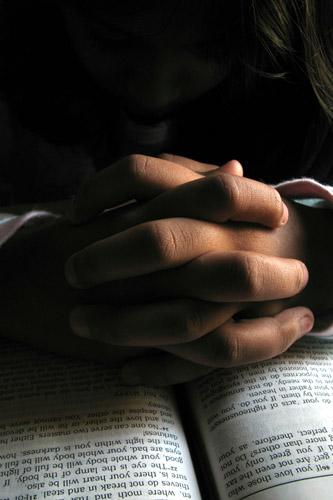
Lent is a particularly powerful time of year to pray. It is a time for us to lay bare our souls and offer atonement for those times we have fallen short. God gives us prayer as a standing invitation to redemption. We can bring our hearts to the Lord anytime we like, in any manner we like, confident that we are heard and loved and understood, no matter what.
Remember, just as there is no one "right" way to pray, so too is it that there is no wrong way for the sincere and devout to lift their voices to God. Below are some techniques and approaches to prayer you may like to consider during Lent and throughout the year.
Liturgy of the Hours
The Liturgy of the Hours is considered the universal prayer of the Catholic Church. It evolved from ancient Jewish prayer schedules formulated during various stages of conquest and exile and later formalized with the rebuilding of the temple. With the dawn of Christianity, monks adopted these schedules for daily prayer.
There are seven time segments to a full Liturgy: morning (lauds), evening (vespers), and night (compline), plus three hours in the mid-morning (terse), midday (sext) and afternoon (none). The Office of Readings occurs during any part of the day.
The breviary that guides the faithful through the Liturgy’s collected Psalms, prayers, canticles and readings has been revised several times throughout history. Following the Council of Trent, the Roman Breviary became the office of the entire Latin Church and the Latin Liturgica Horarium is approved for use throughout the world.
“Liturgy of the Hours,” a four-volume English version that coincides with the seasons of the Church calendar — Advent/Christmas, Ordinary Time 1-17, Lent/Easter, Ordinary Time 18-34 — is approved for use in the United States.
Lectio Divina
Lectio Divina, (divine reading) is a technique of prayer. Its history is ascribed to the Benedictines. It was first established by St. Benedict in the sixth century and its trademark four-step structure was developed by Guigo II, a 12th century monk.
The process was unique in that it did not seek to interpret Scripture, rather it placed Jesus as the universal key to its meaning. Praying Lectio Divina, a person seeks to know Jesus better by taking the sacred word at face value, rather than rely on the powers of analytical thought.
Lectio Divina includes four steps: reading, reflection, response and rest. The person reads a short Scripture passage and reflects on its meaning. The person then responds to God by dropping all conscious thought and opening one’s heart to talk to God, as inspired by the just-completed reflection. During the rest phases the individual does just that, dropping all secular and sacred thoughts to make room for whatever God is telling them.
A number of books are available to help guide the beginner in Lectio Divina. Practitioners say while these can be helpful, beginners should not expect any hard-wired steps and processes. This defeats the purpose. Instead, a person is free to follow where the voice of God leads them.
Centering Prayer
Similar to Lectio Divina, centering prayer is a contemplative technique that places the entire prayer experience in the hands of God. In the ideal scenario, Jesus acts as current and prevailing breeze and the individual a drifting vessel.
In centering prayer, the boundaries are pushed back even farther. An individual chooses a sacred word as the symbol of one’s intention to consent to God’s presence. If a word feels too confining, a mental image of the divine presence or focusing on one’s breathing are also suggested.
The individual closes their eyes as a symbol of letting go of the world and its distractions and engage their thoughts in body sensations, images, memories and perceptions or wherever the mind goes. Once engaged, the sacred word is reintroduced and allowed to take the spirit where it will.
Beginners should expect to invest 30 minutes in the prayer period, while more experienced persons will pray for an hour or longer. The fruits of centering prayer do not happen in the moment, but happen gradually, subtly in daily life, practitioners caution.
Charismatic Catholics
The Catholic Charismatic Renewal began in 1967 at Duquesne University in Pittsburgh. Three popes have acknowledged the movement as a means of spirited renewal among Catholics.
Charismatic gatherings include prayer services, healing services and Mass. Services are remarkable in the energy and enthusiasm of the congregation and celebrants. The faithful may stand, raise their arms, spontaneously affirm or speak in tongues at various points of the service. Lively music, often including electric instruments, is common.
The charismatic movement is rooted in the gifts of the Holy Spirit as delivered to the apostles. Worshipers cite numerous Bible passages talking of charismata (gifts), which are bestowed upon the faithful. Their emphasis on healing, talking in and discernment of tongues, emulates the earliest Church.
Please read our Comments Policy before posting.
Article comments powered by Disqus Winning directory photo honors Our Lady of Guadalupe
Winning directory photo honors Our Lady of Guadalupe
 St. Paul says: How does the Bible define love?
St. Paul says: How does the Bible define love?
 6 steps to getting married in Diocese of Little Rock
6 steps to getting married in Diocese of Little Rock
 Most frequently asked questions on Catholic marriage
Most frequently asked questions on Catholic marriage
 St. Joseph a model of solidarity with immigrants
St. Joseph a model of solidarity with immigrants
 Two gifts after Jesus’ death: Virgin Mary and Eucharist
Two gifts after Jesus’ death: Virgin Mary and Eucharist
 Why we have an altar, and not just a communion table
Why we have an altar, and not just a communion table
 Pope: Wars should be resolved through nonviolence
Pope: Wars should be resolved through nonviolence
 Living relationship with Jesus Christ in the Eucharist
Living relationship with Jesus Christ in the Eucharist